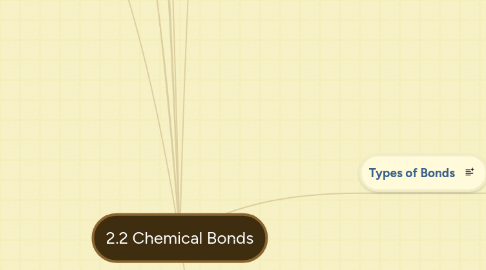2.2 Chemical Bonds
Nazli Ahmedにより


1. Types of Bonds
1.1. Ionic Bond
1.1.1. formed by transferring of electrons
1.1.2. between metals and non metals ... Na and Cl
1.1.2.1. EN difference is greater than 2.0
1.1.3. forms Ionic Compounds
1.2. Covalent Bond
1.2.1. formed by sharing of electrons
1.2.2. between non-metals and non-metals
1.2.2.1. Polar Covalent Bond ... H and O
1.2.2.1.1. EN difference is between 0.5 and 1.6
1.2.2.2. Non-polar Covalent Bond ... O and O
1.2.2.2.1. EN difference is almost the same or less than 0.5
1.2.3. forms Covalent Compounds
1.3. metallic bonds
2. Chemical Bond is the electrostatic attractive force between atoms of elements holding them together
2.1. Bonds help form compounds
2.2. Bonds make atoms act as one single unit
2.3. Can be created by two ways
2.3.1. Transferring of electrons
2.3.2. Sharing of electrons
3. Formed by reactivity of valence electrons ... or electrons in the outer most energy level
4. Terms to know
4.1. Valence electrons
4.2. Octet Rule
4.3. Electronegativity
4.4. Lewis Dot Structure
5. Structures due to Chemical Bonds
5.1. Ionic Compounds
5.1.1. Crystalline Structure
5.2. Covalent Compounds
5.2.1. Individual Molecules

